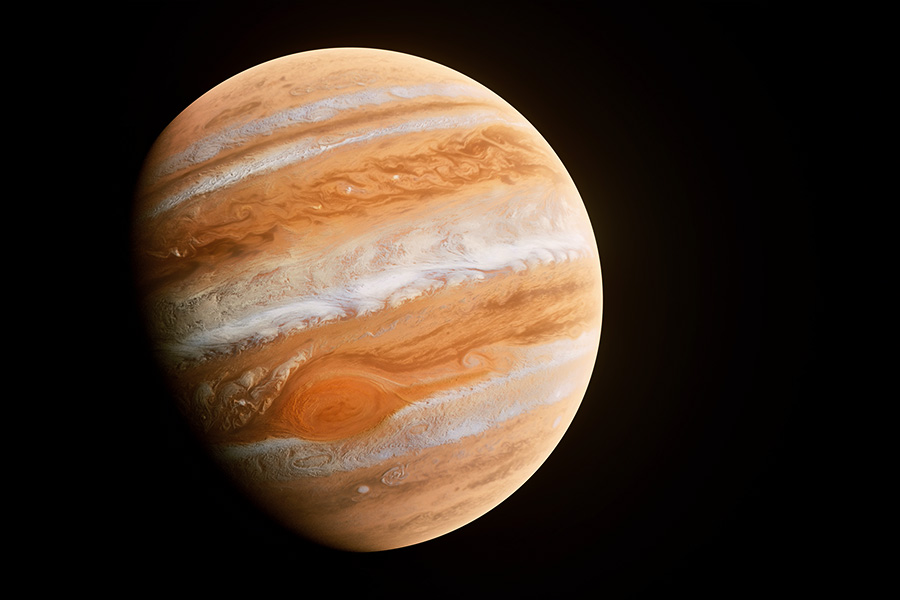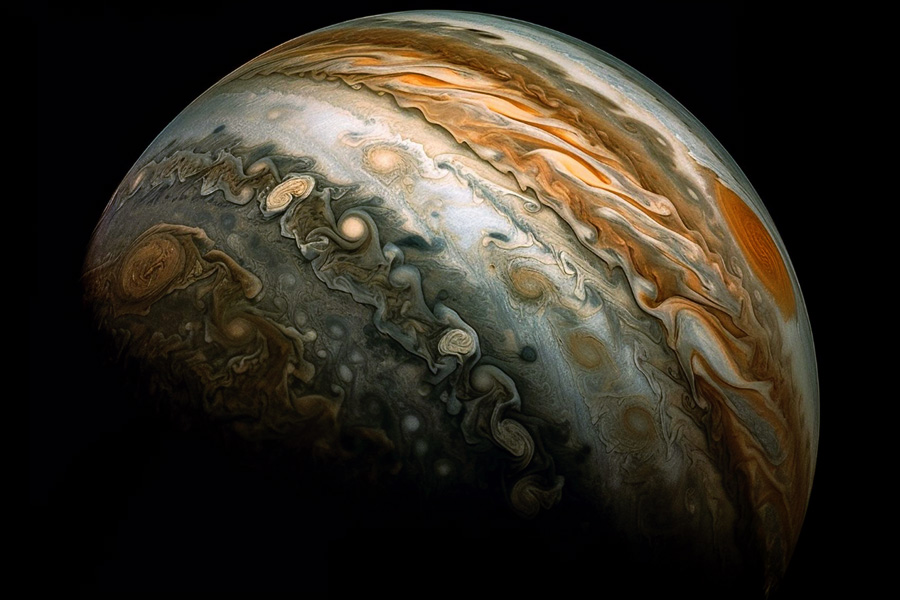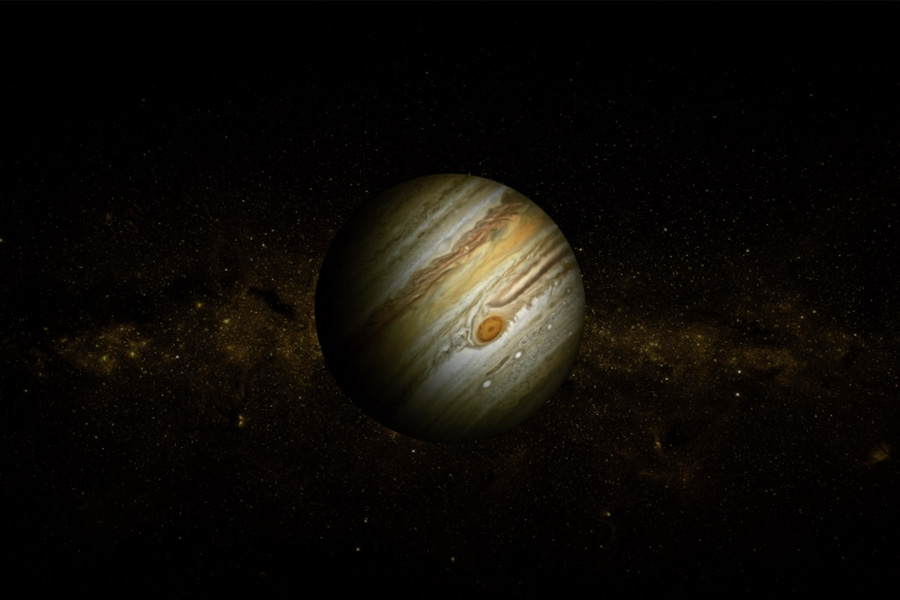Since ancient times, civilizations around the world have gazed up at the night sky and noticed a bright, wandering star – the planet Jupiter. For centuries, Jupiter’s status as a planet was undisputed.
Some scientists have proposed that Jupiter, along with the other gas giants, may not qualify as true planets either. So what exactly is Jupiter? Is Jupiter a Planet as per the latest criteria for defining a planet?
In this article, we’ll look at how planets are defined, examine Jupiter’s key characteristics, and consider arguments for and against its planethood.
Is Jupiter a Planet?
Jupiter is a planet in our solar system, but its planetary status has been questioned due to specific criteria set by the International Astronomical Union (IAU).
While it meets many of these criteria, ongoing debates center on whether it has fully cleared its orbital neighborhood of other objects, a requirement for planetary classification.
While consensus remains elusive, the ongoing debate forces us to rethink what we know about the solar system and its categorization. The discussion ultimately comes down to where we draw the line for an object to attain the lofty title of the planet.
Despite the debate, Jupiter’s colossal size, distinctive features, and influence within the solar system position it as a significant planet.

The Specifics of Jupiter’s Classification
Jupiter is the largest planet in our solar system, but recent debates have called its official status as a planet into question. To understand the controversy around Jupiter’s classification, we need to examine the criteria for planethood set by the International Astronomical Union (IAU) and the arguments for and against categorizing this gas giant as a true planet.
IAU’s planetary criteria
In 2006, the IAU established three primary stipulations for an object to be considered a planet:
- The object must orbit around the Sun.
- The object must have sufficient mass to assume hydrostatic equilibrium, meaning a nearly round shape.
- The object must have “cleared the neighborhood” around its orbit by accreting or gravitationally dominating nearby matter.
Jupiter meets the first two requirements. It orbits the Sun and has sufficient mass and gravity to force it into a spherical, planet-like shape. However, the third criterion causes issues for Jupiter’s status.
Arguments for Jupiter as a planet
Proponents for preserving Jupiter’s designation as a planet point out a few key factors:
| Jupiter has cleared its local area of debris and planetesimals, though its gravitational influence is complicated by its Trojan asteroids. |
|---|
| Jupiter likely formed in a similar way to the terrestrial planets, accreting matter around a core. This sets it apart from smaller dwarf planets |
| Jupiter accounts for most of the mass of the solar system after the Sun, so excluding it seems unreasonable. |
| Jupiter has over 50 confirmed moons, demonstrating its dominance as the core of a planetary system. |
| Jupiter’s impact on the orbits of other planets indicates the major role it plays in the solar system. |
Arguments against Jupiter as a planet
| Jupiter orbits the Sun in resonance with Saturn, and the two exert gravitational influences on each other. This indicates Jupiter has not fully cleared its orbit. |
| There is evidence that Jupiter halted its accretion early in the solar system’s history, stunting its growth. |
| Jupiter is categorized as a gas giant, with different composition and structure compared to rocky terrestrial planets. |
| Jupiter’s mass is only about 1/1000th of the solar system’s mass, far below the threshold to dominate. |
| Jupiter’s stormy, fluid atmosphere is markedly different from other planets. |
Jupiter’s Unique Characteristics
Overview of Jupiter’s size and composition
Jupiter is the largest planet in our solar system, with a diameter of about 89,000 miles – over 11 times the size of Earth. If Jupiter was hollow, approximately 1,300 Earths could fit inside it.
Jupiter is primarily composed of hydrogen and helium, the same elements that make up the Sun.
But Jupiter also contains trace amounts of methane, water vapor, ammonia, and other compounds. Jupiter is believed to have a dense core made of rocky material and metallic hydrogen.

Key features of Jupiter
One of Jupiter’s most iconic features is the Great Red Spot, a massive storm larger than Earth that has raged for over 300 years. Jupiter also has powerful lightning storms up to 10 times stronger than those on Earth.
The cloud tops on Jupiter swirl and mix in turbulent patterns, with lighter and darker bands that each have their own jet streams and cyclonic systems. Jupiter has at least 79 moons, with the four largest being Io, Europa, Ganymede, and Callisto. These four moons were first observed by Galileo Galilei in 1610.
Io is pockmarked with active volcanoes, while an ocean is suspected to lie below Europa’s icy crust. Ganymede is the only moon known to have its own magnetic field. Many of Jupiter’s outer moons have retrograde orbits and are thought to be captured asteroids or fragments of larger moons that broke apart.
Planethood in a Changing Universe
The broader context of planetary discovery beyond our solar system
The debate over what constitutes a planet extends beyond just our solar system. Thousands of exoplanets have now been discovered orbiting distant stars. This gives us an expansive view of the diversity of planetary systems that exist in the universe.
Discoveries like “hot Jupiters” – gas giants orbiting extremely close to stars – challenge preconceived notions about our solar system. Just as Pluto’s reclassification led to a broader conceptual shift, exoplanets indicate there may be entire categories of planets yet to be defined.
The implications of the ongoing debate for our understanding of the Universe
The ambiguity over defining planets even in our own solar system shows how much our knowledge of the universe remains incomplete. Terms like “planet” are human constructs anyway, so arriving at a universal scientific definition is inherently difficult.
Our classification systems are forced to evolve as we gather more data. This process will continue as future discoveries on the galactic scale reveal even more unfamiliar celestial objects. The exciting but unsettled debate over “planethood” is a microcosm of the larger changes in our understanding of the universe.
Ambiguity in planetary classification
Whether considering our solar system or the galaxy at large, there is no clearly delineated threshold where an object definitively becomes a planet. The IAU criteria provide a starting point but lead to edge-case ambiguities.
Jupiter is massive enough to strongly influence other orbits, but should dominance be required? Could a large icy moon ever be characterized as a binary sub-planet in its own right? The universe contains a spectrum of celestial bodies, not all of which fit neatly into categories.
While classifications are useful tools, the mystery endures where exactly the boundary lies for an object to be called a planet. Our understanding will evolve, but places like Jupiter will likely retain their mystique.

Frequently Asked Questions
Is Jupiter a star or a planet?
Jupiter is categorized as a planet. It does not have enough mass for nuclear fusion to occur in its core, which is required for an object to be considered a star. Jupiter orbits the sun and reflects light like a planet. However, with a diameter of 89,000 miles, Jupiter is more massive and spacious than any other planet.
What is the period of revolution of Jupiter?
Jupiter’s period of revolution around the sun is 11.86 years. This means it takes Jupiter nearly 12 Earth years to complete one full orbit.
Jupiter is approximately five astronomical units (AU) from the sun on average, which means its distance from the sun is five times the Earth-sun distance. This substantial distance is the reason for Jupiter’s long revolutionary period.
Does Jupiter have rings?
Yes, Jupiter does have a ring system around it, but it is much fainter and smaller than the rings of Saturn. Jupiter’s rings were first discovered in 1979 by the Voyager 1 spacecraft.
The main ring is broad but very thin, extending about 20,000 miles from Jupiter but only measuring around 30 feet thick. Jupiter also has three other narrow rings. The material in Jupiter’s rings is thought to have originated from small moons that orbit nearby.
Conclusion
So, is Jupiter a planet? Jupiter’s status as a planet remains nebulous despite its prominence in our solar system.
While Jupiter clearly influenced the formation of the solar system, and its massive size gives it planet-like qualities, ambiguity around its orbit and composition still raise questions and ambiguities surrounding the planet’s place in the Universe. However, it’s safe to say that Jupiter still remains a planet, probably the biggest planet in the Cosmos.
